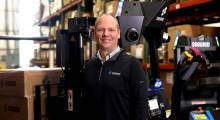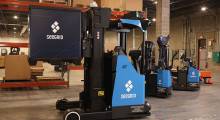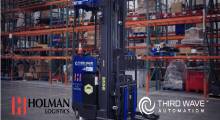Kindred Inc. this week announced it will bring to market an AI-powered robotic system designed to automate the small parcel induction process.
Built on Kindred’s proprietary CORE/AutoGrasp artificial intelligence platform, the INDUCT robotic system is a high-speed workcell that identifies items and determines how to handle them, a process known as induction.
The San Francisco-based company said the system accurately picks, maneuvers, and places items onto a moving belt, bomb bay, or tilt sorter. The platform combines AI-powered machine vision, grasping, and manipulation algorithms to handle parcels of varying size, fragility, and materials.
INDUCT system to help address shortages
The INDUCT work cell will help alleviate capacity shortages and increase efficiency at e-commerce and supply chain companies, according to Kindred. It said the system is addressing a critical need for fulfillment providers at a pivotal time.
“Kindred INDUCT is a highly intelligent robotic system that modernizes induction processes so customers can meet the breakneck pace of consumer demand for e-commerce shipments,” said Marin Tchakarov, CEO of Kindred. “The proprietary Kindred CORE/AutoGrasp reinforcement learning platform is continuously improving, becoming smarter, faster, and more efficient as it learns from millions of picks across our fleet of deployed robots every day.”
Starting with a cluttered avalanche of parcels, the INDUCT in-feed system separates items from a chute onto a series of belts, dividing and unstacking pieces into two organized streams.
Taking advantage of motion controls
Using Adaptive Motion Control, two synchronized robotic arms pick up each item at the precise speed and grip required for its shape and weight and place it on a free space on the moving sorter. Built-in scanners capture barcodes as items move down the sorter, regardless of orientation. Kindred said its INDUCT system can:
-
Grasp and maneuver items up to 4 kg (8 lb.) with a variety of shapes, surface textures, and materials, both rigid packaging and loose plastic
- Induct with throughput of 1,600 – 2,000 picks per hour (PPH)
- Fit within the confines of most induction workstations with a footprint of 2.7 by 1.4 m (8 ft., 10 in. by 4 ft., 6 in.).
“AI and reinforcement learning are in Kindred’s DNA and embedded in all our products, said Anne Marie Neatham, chief operating officer at Kindred. “Those capabilities enabled us to quickly solve the engineering challenge of automating induction – a more challenging process than picking and sorting due to the unstructured and unpredictable dynamics of handling parcels.”
New algorithms at play
Kindred developed several new algorithms to enable the INDUCT system to accurately achieve sortation, induction, and singulation regardless of the item, dimensions, characteristics, or orientation. Integrated into Kindred’s CORE/AutoGrasp reinforcement learning platform, these capabilities can now be deployed in any future Kindred product, the company said.
-
Adaptive motion control—Machine vision, grasping, and manipulation algorithms respond to varying characteristics to ensure each item is suctioned with the right strength, moved at the correct speed, and placed with precision.
- In-process bar-code scanning—A five-sided barcode scanning system captures barcodes on each grasped item while the robotic arm is in motion, maximizing throughput by reducing the need to reorientate parcels.
- In-slot detection—Optimal placement is detected on the sorter using vision systems to monitor both upstream and downstream. The workcell will evaluate whether the item should be placed in a single or double tray, select the next available space, and verify placement accuracy, notifying the scan tunnel of any defects.
Numerous INDUCT workcells can perform collaboratively along the same fulfillment line for maximum productivity, said Kindred. Customers can also integrate them with many different communication protocols, customizations, and customer and warehouse management systems (WMS).
Kindred added that its integration team can develop customized screens for cycle reporting, performance statistics, and parameter configuration. The company is part of the Ocado Group, which is based in the U.K.
Article topics
Email Sign Up

















